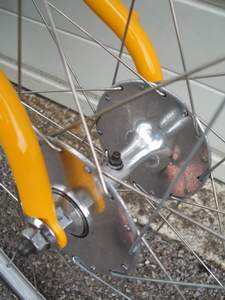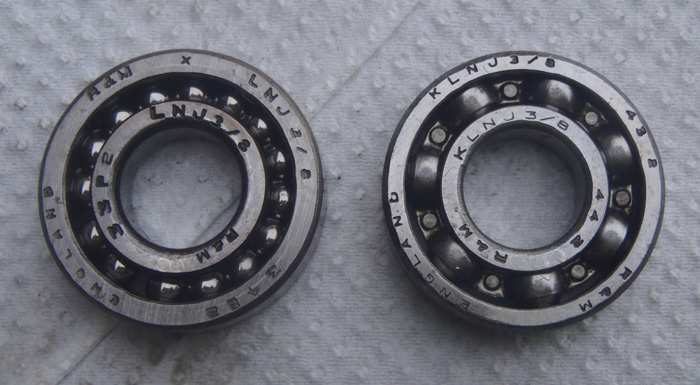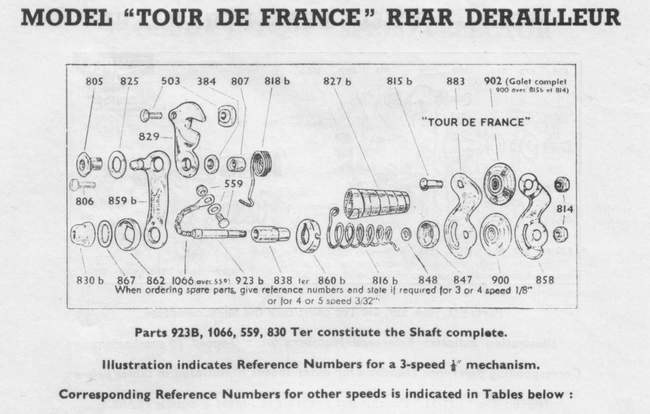Harden hubs - bearing replacement
Posted: Monday 21st September 2020
The Harden hub is one of the few hubs, especially from the immediate post-war- years, to use a caged non-adjustable bearing rather than the cones and locknuts commonly used by other manufacturers. The hub shell is aluminium alloy, cast as one piece, then machined and polished and fitted with standard Teclamit grease nipple. They were produced as both large and small flange with the large flange sold both as drilled (for lightness) and undrilled – known as the ‘Bacon Slicer’ – see right. The large flange were 3¼” diameter and drilled with ½” diameter holes.
The original ball bearing races were Hoffman but amazingly if you go into a bearing stockist to this day and ask for bearing KLNJ 3/8 Y there is a fair chance they will have them in stock. The last I bought were high quality Swiss RHP bearings and cost just over £20 for two but I have heard of much cheaper bearings from other sources. I bought the Swiss ones as they were in stock and patience is not what I am known for.
The hub consists of the hub shell, the spindle made from high tensile (65 ton) special alloy steel, the two bearings, two alloy oil-seal discs and two alloy nuts which hold the whole assembly together.
Hardens were coveted by most riders in the 50’s where the classic wheel set-up was a pair of large-flange Hardens laced into a pair of Conloy Asp HP or Conloy Sprint rims possibly with the spokes tied and soldered. This combination, especially with the Asp HP rims, gave you a pair of wheels which looked almost too good to use. The proportions were perfect and you just wanted to polish them and gaze at them, especially if they were in your bedroom, which is where they were kept so as to be the last thing you saw at night and the first thing in the morning. If they were standing against the wall with a picture of Eileen Sheridan hanging above you were in a state of bliss as you dozed off!

However, eventually (probably after about fifty years) comes the time when the silky spinning of the wheel begins to feel a bit gritty and the time has come to give the wheel an overhaul.
I am told it is essential to remove the grease nipple first to avoid damage.
The first job is to remove the outer nuts (assuming you already have the track or wing nuts off) and it pays to remember that axle threads get slightly deformed where it sits in the fork ends. The Harden axle has flats so it is possible carefully to put the axle in a vice whilst getting these nuts off.
Once they are off, take a fairly substantial polyurethane hammer and tap one end of the axle. After a few taps you will notice that the oil seal has come away so remove it from the axle and put to one side. Next to come away should be the caged bearing.
Now it is possible to remove the axle from the hub and having done so support the inner edge of the attached ball race (say on a vice opened a fraction more than the axle diameter) and again tap with the hammer until the seal and bearing come off the axle. You should now have the shell and seven components including the axle.
After carefully cleaning everything it is now time to reassemble. Note that if you have a gear/fixed hub that the axle threads will be longer one side than the other.
Take one of the cages (assuming that you have fingered grease into it from both sides) and slide it up the axle and then use the vice as before except this time to tap the axle in. It is a good idea to cut a ring/disc in a sympathetic material to avoid scratching the hub, best would be a disc with a centre hole which pushes equally on inner and outer bearing races.
Now feed the axle into the hub and slide on the other bearing – it is now possible to use the open vice again to support the bearing whilst it is tapped in by the opposite axle end.
All that remains now is to slide on the seals and then the retaining bolts – you may have to hold the axle flats in the vice to stop them twisting.
If there are no flats on the axle it is possible to use two nuts locked together on a free part of the axle. These nuts can now be clamped in the vice to hold it whilst you work on it.
These instructions work with hub only or with a built-up wheel. Working with a complete wheel you need the radius of the wheel clear on all sides of the vice.
Harden also produced a cheaper hub, the ‘Flywate’which had conventional cups and cones. This hub was large-flange only.
Where I mention using a vice it is essential to have a covering over the metal faces of the vice to avoid damage to the aluminium components of the hub. If you are doing several hubs it is possible to create simple ‘jigs’ to assist.
We have more technical information from Tony Jenkins:
As there was a little lateral movement in a Mercian rear wheel I owned, I ordered some new bearings then investigated.
As you can see from the photo the bearings on either side were different. Both are R&M a LNJ and a KLNJ. One, and the replacements I bought, have 7 balls, yet the “odd” one , which could well be an original has more balls, and on the other side filling slots to get them in.

I’m no engineer, and it may be counterintuitive, but these look stronger. Considering the comment in Steve Griffiths book that these 7/32″ wide bearings were not up to the job, I’m wondering — were the originals stronger than the current replacements?
This has been niggling me so have looked into this a bit more and come to the following conclusions:-
1. The preferred bearing is LNJ 3/8, not the readily available and cheap KLNJ 3/8. Both are the same dimensions , it’s just the LNJ is packed with balls through a filling slot and therefore has a far greater load capacity.
2. If, as comments suggest, the original bearings were not up to the job, then the it is likely Harden used the stronger LNJ’s (3 out of 4 on my Mercian were these). It may have been just availability and cost caused people to switch later to the cheaper KLNJ type.
3. I have just bought 4 x LNJ 3/8, they are expensive but still available as new/old stock if you look.
4. Both this website and others e.g. http://pardo.net/bike/pic/fail-024/000.html
have information on Harden hubs.
Posted: Monday 21st September 2020
Contents
This article appears in the following categories.
Upcoming Events
Whether you are looking for a gentle social meet up, or a 100-mile ride browse the community’s upcoming events and plan your next weekend outing.
